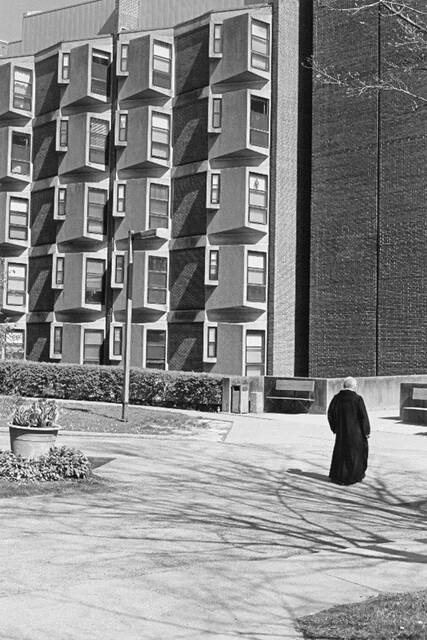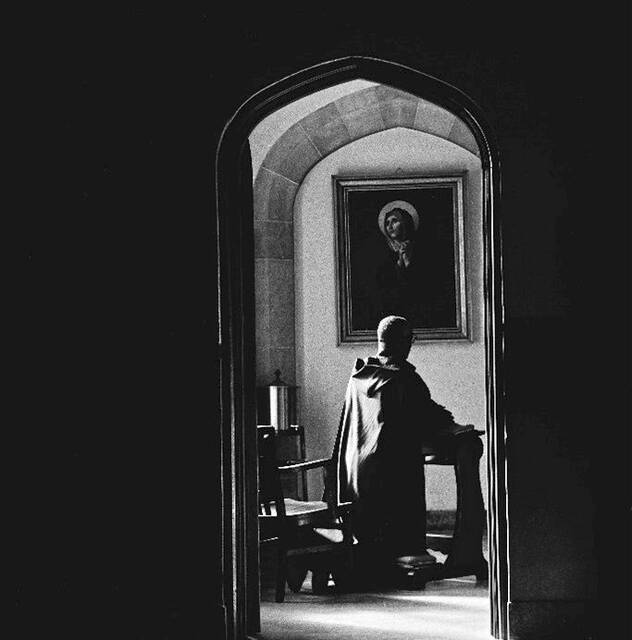Saint Vincent photo exhibition reveals private side of monastic life
Among lesser-known works by renowned 20th-century photographer, author and filmmaker Gordon Parks is a series of photos taken for a 1955 “Life” magazine photo essay documenting life among the monks of Saint Benedict’s Abbey in Atchison, Kan.
The 30 Parks photos will be paired with work by Pittsburgh-based photographer Dominick McDuffie in an exhibition titled, “Worship + Work,” running June 16-Aug. 19 in the Verostko Center for the Arts at Saint Vincent College.
Parks’ essay, “A Cloistered Life of Devotion,” gave readers a glimpse into the mid-century community of American Benedictines by documenting their daily routines of prayer, work, study, recreation and rest.
McDuffie has done the same for the modern-day members of the Benedictine monastery at the Unity campus.
Growing up in Kansas City, Andrew Julo, the exhibition curator and director of the Verostko Center, was familiar with the Abbey’s collection of the Parks photos, because they had been framed at a gallery where he once worked. He also had visited Saint Benedict’s on a field trip with his Catholic elementary school.
Julo contacted the Abbey about a loan of the photos, suggesting a swap of works from the Saint Vincent collection.
He met McDuffie at the Carnegie Museum of Art in Pittsburgh, where the 28-year-old photographer was leading a workshop in tandem with the museum’s Teenie Harris Archive, and offered him a commission to create images for “Worship + Work.”
“There are parallels between Parks and Dominick, being that they both started photographing in their 20s, both acquired their first camera at a pawn shop and both were self-taught,” Julo said.
McDuffie specializes in documenting under-represented communities.
“(Parks) was one of my first entries into photography, by learning about his work and also being a Black photographer,” said McDuffie, who has a residency at the Boom Concepts studios and artist resource center in Garfield. “His work is super-iconic. I was a little nervous being in the same space as his work, but it put the pressure on me to make my images the best I could do.”
A different world
McDuffie made repeated, lengthy visits to the Saint Vincent monks.
“At first, we took a visit and I was able to meet various different monks, and sit down and have a meal. It was an icebreaker,” he said. “During that time, I would talk to various ones and go to different areas on campus. That gave me different insights and more opportunity to get some of their stories, their family history and how they became monks.
“It was very interesting because it was a totally different world that I was being exposed to.”
By spending time with the monks in their private spaces, Julo said, McDuffie was doing the same thing that Parks would have done.
“Part of (McDuffie’s) process was being a fly on the wall in moments in the monastery that people don’t normally see, in places that are essentially off-limits to the public,” Julo said. “He talked about the process of getting to know people, to have them feel comfortable in his presence, which elicits better photos.”
Like Parks, McDuffie worked with a 35-millimeter camera and black-and-white film, but there was no attempt to mimic the master’s work.
“This is not a project in which he is creating mimesis. He was not trying to create re-representation, but something that did have some visual similarities,” Julo said. “The black and white is probably the major continuity.”
“Work + Worship” will open with a reception from 4 to 7 p.m. June 16 in the Verostko Center, on the second floor of the Dale P. Latimer Library.
The exhibition will be open for viewing during the Verostko Center’s summer hours, 10 a.m.-4 p.m. Tuesdays-Thursdays, and by appointment. Visits can be arranged by emailing verostkocenter@stvincent.edu.
When Julo returns the Parks’ photos to Saint Benedict Abbey, he also will deliver a loan of 19th-century architectural drawings from the Saint Vincent collection — two of which actually depict St. Benedict’s.
“There’s a system of Jesuit colleges and galleries that communicate with each other, and I’m interested in us having these deeper conversations among the various Benedictine establishments and having more of these exhibitions,” he said. “Everybody has these treasures and interesting things, and it’s nice for us to be able to share them and expose them to a public that wouldn’t normally see them.”
For more information, visit verostkocenter.org.
Shirley McMarlin is a Tribune-Review staff writer. You can contact Shirley by email at smcmarlin@triblive.com or via Twitter .
Remove the ads from your TribLIVE reading experience but still support the journalists who create the content with TribLIVE Ad-Free.



